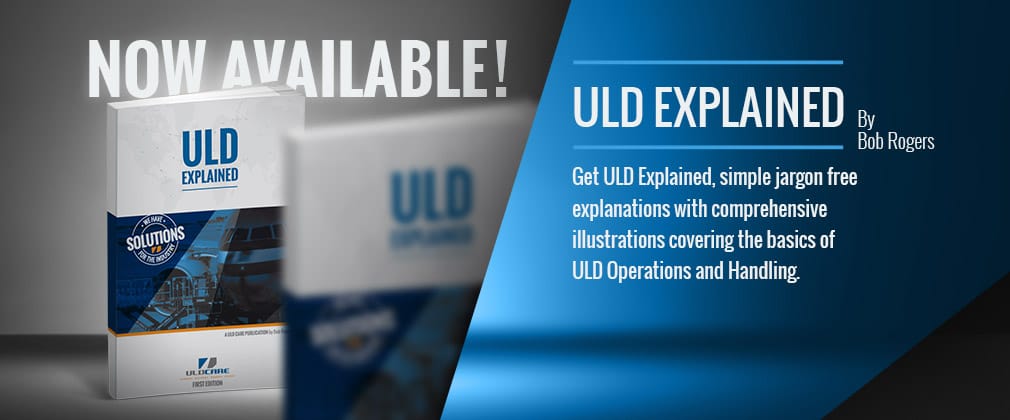
The ULD Explained book delivers exactly what it says on the cover –simple, jargon-free explanations with comprehensive illustrations covering the basics of ULD Operations and Handling.
The ambition of ULD Explained is to fill a long standing shortage of basic, easy to read and understand ULD material for those who are new to ULD or who today are working with or around ULD but have never had the benefit of any formal instruction. Currently published ULD material is of use to those having a good basic knowledge but is not so appropriate for those who do not, and there is an ever increasing category of people who when it comes to ULD are expected to “just figure it out”.
Aircraft safety and “just figure it out” do not go together, ULD Explained goes some way to resolve this unsustainable state of affairs.
Buy Now!
Read the
Book Introduction
The concept behind ULD Explained comes from some work carried out in 2014. At that time I was asked to draft up some material for inclusion in the IATA Ground Operations Manual (IGOM), a new standard that would define the task- by -task working practices for the whole spectrum of ground ha ndling operations. It sounded simple enough to do something along these lines for ULD, so I got started on drawing up some material. The assumption that this would be easy turned out to be incorrect for two reasons.
Firstly, writing task instructions is very different from drafting standards such as found in the IATA ULD Regulations. The ULDR tells you how things must turn out, while the task- by -task material tells you how to get there. This requires each statement to be written using very clearly defined and simple wording that removes the need for guesswork. Secondly, during the process we uncovered some aspects of ULD operations that required a close analysis and debate about exactly how a certain action should be done. We knew what outcome was wanted, we knew how the industry was doing it today, but when it came to putting onto paper a set of instructions that would do the job properly each and every time, challenges presented themselves.
After a number of months of hard work the project was complete, running to many pages, and was passed on to the people responsible for IGOM within IATA – and that might have been that. But it wasn’t!
Working on task-level instructions opened up a whole new perspective on how best to encourage and support safe and quality ULD operations, and one of the outcomes was the idea for a “ how to ” book on ULD. We have the IATA ULDR, which sets the standard, but not so many people will get the chance to read its 688 pages, so what about something written in easily readable language that lays out an explanation of how to carry out basic ULD operations?
ULD Explained is the outcome of that idea. I hope it will come to be the “ go to ” tool for anyone wanting to increase their understanding about ULD. After all, th ey inhabit many, many airports, not to mention being found in cargo terminals and freight forwarders facilities, so a great number of people work with and around these essential tools of the airline and air cargo industry. It can be the book given to someone new to ULD to spend a couple of hours getting an overview, or the book that an old hand uses to check out something they aren’t sure about, or anywhere in between.
They say a picture is worth a thousand words, and when it comes to ULD this is certainly all too true. T he ULD “ chain ” is so long and disconnected that all too often one person is performing a particular function with no idea what happens next, and this is particularly true when it comes to the final stage of any ULD build-up, where the ULD is placed in the aircraft and ready for flight. ULD Explained contains a large number of illustrations, not because photos of the inside of aircraft cargo holds, or of ULD on dollies, or of damaged ULD, are of any particular beauty – they are not – but because by including them I hope to bring to life the whole process, from some basics through taking a ULD out of storage, though transport, inspection, build- up and then loading onto the aircraft, and then onto transfer, accessories and fina lly special ULD and special cargo.
They also say timing is everything and certainly the time seems right to publish ULD Explained. Firstly, technology is on our side. It has never been easier to economically publish a speciality book such as this, both in hard copy and as an e-book. Secondly, the “ ULD conversation ” is gaining momentum; the hard, hard work of both IATA and ULD CARE since 2010 to get ULD the awareness it deserves is now paying off, and like ripples in a pond the word is reaching further and further into the far flung corners of the air cargo industry. Combined with other initiativ es, such as the ULD CARE video, SOS ULD and the IATA ULD Safety Campaign, it is my ambition that ULD Explained will expand a general appreciation of ULD across the industry.
After 40+ years it might seem that ULD is a pretty stable part of the industry, quite unlike topics such as DG or security, where new risks and threats are cause for c onstant changes in regulations and practices. How wrong this would be, since flight sa fety, of which ULD is a co mponent, is a constantly evolving subject, and every year brings signi ficant changes to the way cargo operations and ULD are expected to operate. Add into this pot the tremendous growth in the transport of high- end pharmaceuticals, driving the need for a whole gene ration of special purpose active Temperature Controlled Containers, and the developmen t of Fire Containment Covers and Fire Resistant Containers designed to help mitigate the risks associated with lithium batter ies, and you can start to see that managing ULD operations is not at all a static job. New demands will continue to drive change and innovation in ULD design, operations and handling.
ULD Explained does not set out to be the ultimate reference for all matters related to ULD – that would be a job for the IATA ULD Regulations – but I do hope that it will bring a better understanding of the subject of ULD to anyone choosing to read the book.
As I enter my 36th year in and around ULD, I have told many people that ULD is like Hotel California: o ne can check out but never leave, and I know I’m not alone in having an interest in this rather specialist and even obscure subject. We must never ignore that every minute of every day at airports around the world ULD are being stored, tr ansported, built up and placed in aircraft. I do hope that ULD Explained will bring a greater understanding of these processes to the tens of thousands of people who make this happen.
Bob Rogers
Vice President & Treasurer / Author
ULD CARE
Acknowledgements
I would like to acknowledge the assistance provided by the following people and organisations in the creation of ULD Explained.
- Cathay Pacific Airways – Alan Glen and the Cargo Services Team for both luncht ime discussions and for making photo-taking sessions on freighter and passenger aircraft possible.
- Das Nordisk Limited – for their help in arranging ramp permits and transport for my various ramp excursions.
- Hong Kong Air Cargo Terminals – for their help in taking photos of cargo te rminal operations.
- IATA – for permission to use IATA material in some illustrations.
- Urs Wiesendanger and Louise Ladouceur of ULD CARE for their interest, encouragement and brainstorming during the process



